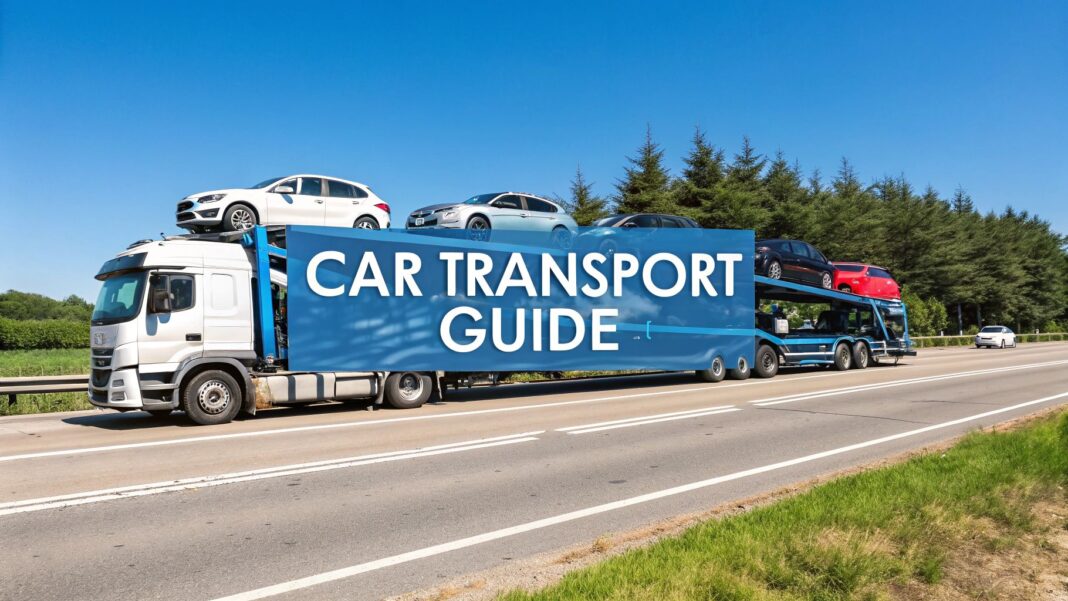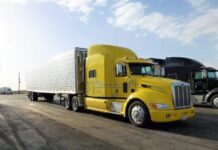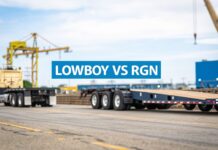
When you see a massive truck loaded with cars on the highway, you're looking at a highly specialized piece of equipment. These aren't just trucks; they are purpose-built machines designed for the specific job of moving vehicles safely and efficiently.
Choosing the right one is a critical first step. The best truck for your car depends directly on your vehicle type, budget, and desired level of protection. Making an informed choice here is the key to a smooth, worry-free transport experience.
Understanding the World of Car Transport Trucks

Think of car carriers as specialized tools. You wouldn't use a sledgehammer for delicate engine work, and the same logic applies here. A priceless vintage Ferrari shouldn't be shipped on the same open-air truck that delivers new sedans to a dealership.
The auto transport industry provides a range of options because every vehicle and owner has unique needs. From the common open haulers to fully enclosed trailers that act as mobile garages, each truck offers a different balance of cost, security, and speed. Understanding these differences is crucial for a successful shipping experience.
What This Guide Covers
This guide provides actionable insights to help you confidently select the right transport method. We will analyze the pros, cons, and ideal use cases for every major type of car carrier.
Here’s a practical breakdown of what we’ll cover:
- Open Car Haulers: The industry standard. Learn when their cost-effectiveness is the right call for your vehicle.
- Enclosed Car Carriers: The premium choice. Understand when the added cost is a necessary investment for maximum protection.
- Specialized Trucks: The problem-solvers. Discover solutions for inoperable cars, oversized vehicles, or urgent hotshot deliveries.
By the end of this guide, you will have the knowledge to assess your specific situation—whether shipping a daily driver or a high-end luxury car—and choose the optimal truck for the job.
Our goal is to give you a clear roadmap, removing the guesswork from the process. This ensures your car arrives safely, on schedule, and within your budget. Let’s begin with the most common truck on the road.
Open Car Haulers: The Backbone of the Industry
The truck you typically envision hauling cars is an open car hauler. These are the undisputed workhorses of the auto transport industry, responsible for moving the vast majority of vehicles across the country.
Their two-level skeletal frame is a design focused on pure efficiency. This setup allows a single rig to transport anywhere from eight to ten standard-sized cars, which is the primary reason for their industry dominance.
This high capacity is the key to open transport's value proposition. By distributing the operational cost across more vehicles, carriers can significantly lower the price per car, passing those savings directly to you. It is the most cost-effective and readily available shipping method.
The Big Upside: Cost and Convenience
The number one reason to choose open transport is its affordability. With more cars sharing the journey, the individual cost drops significantly. It’s the most economical option for standard vehicle shipping.
High availability is the other major advantage. Since most carriers operate open trailers, finding a spot for your car is typically fast and straightforward. This gives you a much better chance of securing a quick pickup date compared to more specialized options.
The scale of this operation is immense. The global car carrier market was valued at USD 9.52 billion in 2024, highlighting the critical role these trucks play in vehicle logistics. This data underscores how essential these transport services are to the automotive industry.
What's the Catch?
The open-air design that makes these haulers efficient comes with a clear trade-off: your vehicle is exposed to the elements, just as it would be if you were driving it.
This exposure includes:
- Weather: Sun, rain, snow, and hail are potential factors during transit.
- Road Debris: Dust, dirt, and small rocks kicked up by other traffic are an unavoidable part of highway travel.
This means your car may arrive with minor cosmetic issues, like a new layer of road grime or a small paint chip. For most standard vehicles, such as a daily driver or family SUV, these minimal risks are an acceptable trade-off for the significant cost savings. You can explore the process further in our detailed guide on open trailer auto transport.
For example, shipping a reliable Toyota Camry from Chicago to Phoenix on an open carrier is a practical and affordable choice. However, for a pristine classic Mustang, the risk of even minor damage might lead you to consider a more protective option.
Enclosed Car Carriers: Maximum Protection for Your Vehicle
If an open hauler is the economy option for auto transport, an enclosed carrier is the first-class alternative. These trucks function as secure, mobile garages, providing the highest level of protection for your vehicle during transit.
Unlike open carriers, enclosed trailers completely shield your vehicle from the outside world. This ensures total protection from rain, hail, road debris, and potential security threats. For high-value or delicate vehicles, this level of protection is essential.
Hard-Sided Versus Soft-Sided Carriers
Enclosed carriers come in two primary types. Understanding the distinction helps you select the right service for your specific needs.
- Hard-Sided Carriers: These are fully encased in metal, similar to a standard semi-trailer. They offer the ultimate defense, completely securing your vehicle from all external elements and potential impacts.
- Soft-Sided Carriers: These trailers utilize a heavy-duty, weather-resistant canvas stretched over a rigid frame. They provide excellent protection from most weather and road hazards and are often a slightly more affordable enclosed option.
The image below provides a clear visual comparison of how these premium trucks differ from standard open carriers.

The key trade-off is paying a higher price for lower capacity in exchange for superior protection.
To help you make a quick decision, here is a direct comparison of the two main types of car transport trucks.
Open vs Enclosed Car Carriers At a Glance
This table breaks down the key differences to help you decide which car transport truck is right for your needs, based on what matters most to you—cost, protection, or the type of vehicle you're shipping.
| Feature | Open Car Carrier | Enclosed Car Carrier |
|---|---|---|
| Cost | More affordable | 30-60% more expensive |
| Protection | Exposed to weather and road debris | Fully protected from all elements |
| Security | Lower security against theft/vandalism | High security, fully concealed |
| Ideal For | Daily drivers, standard sedans, SUVs | Luxury, classic, exotic, and race cars |
| Availability | Widely available, more frequent routes | Less common, may require more lead time |
| Capacity | 8-10 cars per truck | 1-7 cars per truck |
Ultimately, the choice comes down to balancing your budget with the level of protection your specific vehicle demands.
When to Choose an Enclosed Carrier
When does the extra expense of an enclosed truck become a necessary investment? This service is designed for vehicles where even minor damage is unacceptable. It is the definitive choice for owners who require 100% certainty that their car will arrive in pristine condition.
An enclosed carrier is the only choice when shipping a vehicle whose value goes beyond simple transportation. It’s an investment in preserving the condition, integrity, and worth of a special automobile.
Here are specific scenarios where an enclosed carrier is the most logical choice:
- Classic and Antique Cars: To protect the flawless finish and irreplaceable value of a 1967 Shelby GT500 or a vintage Rolls-Royce, white-glove service is mandatory.
- Luxury and Exotic Sports Cars: For high-end vehicles like a Lamborghini, Ferrari, or Porsche, enclosed transport prevents road debris from damaging delicate and expensive paintwork.
- Race Cars and Custom Builds: These vehicles often have unique dimensions and handling requirements that demand the specialized equipment and expertise found with enclosed carriers.
The primary disadvantages are the higher cost—typically 30-60% more than open transport—and potentially longer wait times due to the limited number of these specialized trucks. While it's overkill for a standard daily driver, it's an essential safeguard for a valuable automotive asset. To learn more, you can learn more about the specifics of enclosed car transport and its benefits.
Specialized Trucks for Unique Transport Needs

While large open and enclosed haulers handle the majority of car shipping jobs, they aren't always the right tool. Certain situations demand specialized rigs designed for unique vehicles or urgent timelines.
If a standard multi-car hauler is like a commercial airliner, these specialized trucks are like private jets. They offer speed, flexibility, and access to locations that are off-limits to larger carriers, solving logistical challenges that would otherwise be insurmountable.
Hotshot Trailers for Speed and Flexibility
A common specialized setup is the hotshot trailer. This typically consists of a heavy-duty pickup truck (like a Ford F-450 or Ram 3500) towing a gooseneck trailer designed for one or two vehicles. This configuration is built for agility and speed.
Because they operate independently of large, multi-stop routes, hotshot carriers are ideal for specific tasks:
- Expedited Shipments: If you need your car delivered on a tight deadline, a hotshot offers direct, point-to-point service.
- Last-Mile Deliveries: They can easily navigate tight residential streets or crowded dealership lots where a 75-foot carrier cannot go.
- Short-Distance Hops: For local moves between dealerships or from a port to a nearby facility, a hotshot is highly efficient.
Flatbed and Tilt-Deck Trucks for Special Cases
For vehicles that cannot be driven onto a trailer, a flatbed or tilt-deck truck is essential. These rigs are designed to move damaged, inoperable, or unconventionally shaped vehicles.
The tilt-deck is particularly useful, as its bed can be hydraulically lowered to the ground. This creates a gentle ramp, allowing a vehicle to be winched aboard safely and with minimal effort.
These trucks are the go-to solution for:
- Inoperable Vehicles: Ideal for transporting a classic barn find, a project car, or a vehicle damaged in an accident.
- Custom or Oversized Vehicles: A flatbed is often the only way to move a lifted truck, a heavily modified car, or other large items.
- Salvage and Auction Hauling: They are frequently used at salvage yards to transport vehicles that are no longer roadworthy.
The availability of these trucks is influenced by the broader commercial vehicle market. For instance, recent commercial vehicle forecast on spglobal.com suggests that new registrations for heavy-duty Class 8 trucks—the foundation of many transport fleets—could drop by 8% in 2025. Such market shifts can impact shipping costs and fleet modernization across the industry.
Key Factors When Choosing a Car Transport Service
Now that you understand the different types of trucks, it's time to apply that knowledge. Selecting the right service involves more than just picking a truck type; it's about matching the service to your vehicle, budget, and timeline.
By systematically evaluating these key factors, you can move from simply finding a shipper to choosing a reliable transport partner.
Balancing Budget and Vehicle Value
The first consideration for most people is cost. While budget is important, it must be balanced against the value of the vehicle being shipped. An open carrier is the most economical choice and is perfectly suitable for daily drivers, sedans, and family SUVs.
However, the calculation changes for a high-value collector car, a rare exotic, or a sentimental antique. For these vehicles, the minor risk of a rock chip from an open carrier is often unacceptable. In such cases, paying the premium for an enclosed carrier is not a luxury—it's a prudent investment in protecting your asset.
Factoring in Timeline and Distance
How quickly do you need your car? Your timeline is a major factor in determining your options. Standard service on a large multi-car hauler operates on a complex schedule with multiple stops, which can extend transit time, especially over long distances.
If you have a strict deadline, you should investigate expedited services. These often utilize smaller, more direct carriers like hotshot trucks. While this speed comes at a higher price, it can be a worthwhile investment when time is critical.
Key Takeaway: The farther your car has to travel, the more important it is to select a carrier with a solid, proven track record. Coast-to-coast transport is a serious undertaking that demands experienced drivers and impeccably maintained equipment.
Vetting the Company and Insurance
A transport service is only as reliable as the company behind it. Before committing, perform thorough due diligence. Look beyond the company website to read customer reviews and check their official safety ratings. A reputable company will be transparent about its insurance coverage and should readily provide a copy of its policy.
Confirm that their cargo insurance is sufficient to cover the full value of your vehicle. The U.S. trucking industry is massive, with roughly 13 million large trucks in operation. With so many companies to choose from, taking the time to properly vet a carrier is your best protection against a negative experience.
For a step-by-step guide, review our article on how to find a good car shipping service. You can also explore current trucking industry statistics on geotab.com to understand trends like AI fleet management and the rise of electric trucks.
Wrapping It Up: Choosing the Right Ride for Your Car
Navigating the world of auto transport can seem complex at first, but it becomes clear once you understand the primary types of trucks that transport cars.
You have cost-effective open car haulers, which are widely available and ideal for standard vehicles. For valuable or delicate cars, enclosed carriers offer superior protection. And for special circumstances, nimble hotshot trucks and versatile flatbeds provide tailored solutions.
The right choice depends entirely on your priorities. It’s about finding the optimal balance between your budget, your car's value, and your required delivery timeline.
You now have the practical knowledge to make an informed decision. Instead of choosing a service at random, you can confidently select one that aligns protection, speed, and cost with your specific needs.
What's Next?
Before you book, run through this simple checklist:
- What am I shipping? A daily driver points toward an open carrier, while a priceless classic demands an enclosed one.
- What’s my budget? Establish a realistic budget to help you weigh the affordability of open transport against the premium security of enclosed shipping.
- How soon do I need it? Determine if a standard delivery window is acceptable or if you require expedited service, which might necessitate a dedicated hotshot carrier.
Answering these questions will guide you directly to the right type of truck, ensuring a safe and smooth transport process for your vehicle. You have the information—now you can book with confidence.
Your Top Questions Answered
If you're new to shipping a vehicle, you probably have a few questions. That's completely normal. Let's walk through some of the most common things people ask about how car transport trucks work and what you can expect from the process.

So, How Much Does It Really Cost to Ship a Car?
There is no single price for shipping a car. The final cost depends on several key variables, much like booking a flight.
Here are the primary factors that influence your quote:
- Distance: Longer distances increase costs due to higher fuel consumption, driver time, and wear on the truck.
- Vehicle Size and Weight: A large SUV or pickup truck occupies more space and weight capacity on a trailer than a compact car, resulting in a higher price.
- Truck Type: This is a major cost driver. Choosing an enclosed carrier for maximum protection will typically cost 30-60% more than a standard open carrier.
- Time of Year: Prices can be higher during peak seasons, such as summer or holidays, due to increased demand.
As a general estimate, shipping a standard sedan coast-to-coast on an open carrier typically costs between $1,100 and $1,500. The same trip using an enclosed carrier could range from $1,600 to $2,200 or more.
Is My Car Insured While It's on the Truck?
Yes. Federal law requires all licensed auto carriers to maintain a cargo insurance policy to cover potential damage to the vehicles they transport.
However, coverage details vary between companies. Before you book, it is a crucial and actionable step to request their certificate of insurance.
Don't just take their word for it. Always get a copy of the carrier's insurance policy and give it a quick read. You'll want to know the coverage limits, what kinds of damage are covered, and if there's a deductible you'd be on the hook for. It's a simple check that gives you serious peace of mind.
How Long Does It Take for a Truck to Get My Car There?
Delivery time is primarily determined by distance. While a driver covers significant ground daily, the total transit time includes more than just driving.
Here are some general transit time estimates:
- Shorter Trips (under 500 miles): Typically 1-3 days.
- Cross-Country Hauls (over 2,000 miles): Plan for 7-14 days.
These are estimates. Delays can occur due to weather, traffic, or mechanical issues. A multi-car hauler makes numerous stops for pickups and drop-offs, which extends the overall schedule. Always get an estimated delivery window from your transport company and allow for some flexibility.
Ready to ship your vehicle with confidence? At We Will Transport It, we handle all the logistics to ensure your car, boat, or heavy equipment arrives safely and on time. Get your free, no-obligation quote today and let our experts manage the journey. Visit us at https://www.wewilltransportit.com to get started.







